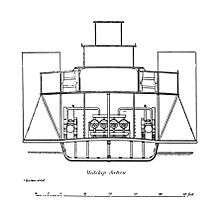Guards (steamboat)

Guards on a steamboat were extensions of the main deck out from the boat’s main hull.[1] Guards were originally adopted for side-wheel steamboats to protect the paddle wheels and to provide a mounting point for the outer ends of the paddle wheel shafts.[1] The main deck planking extended out over the guards, and when a steamboat was fully loaded, and sunk deeply in the water, it often appeared that the edges of the guards marked the line of the hull.[1]
The size of the guards was governed, on a sidewheeler, by the width of the paddle-wheels and their housings.[1] On early steamboats operating on the Mississippi and Ohio rivers the overall width of the vessel, counting the guards, did not exceed more than about one-third of the hull width.[1] However, by the 1850s, the width of the guards in extreme cases was more than twice the width of the hull.[1]
For example, the hull of the Jacob Strader, a large vessel (905 tons) built in 1853 for the Cincinnati and Louisville Mail Line, was 27.5 feet wide, but measured over the guards the main deck was 69 feet across.[1] While the Strader was an extreme case, it was common for guards to make the main deck 50 to 75 per cent wider than the hull.[1]
Guards were also used on sternwheelers, where, with the paddle wheel being mounted at the stern, they had no structural function on the vessel.[1] On sternwheelers the guards gave additional room to store freight and fuel, allowed a passage between different parts of the boat, and provided a place for passengers to promenade.[1]
One problem with guards was that they could make the steamboat less stable, and with the type of boilers used on the Ohio-Mississippi boats, even a list of ten or twelve inches to one side could cause the boilers to malfunction, which, if prolonged, could result in an explosion.[1] This was difficult to manage, especially when for example passengers would crowd along one side of a boat to observe an attraction.[1]